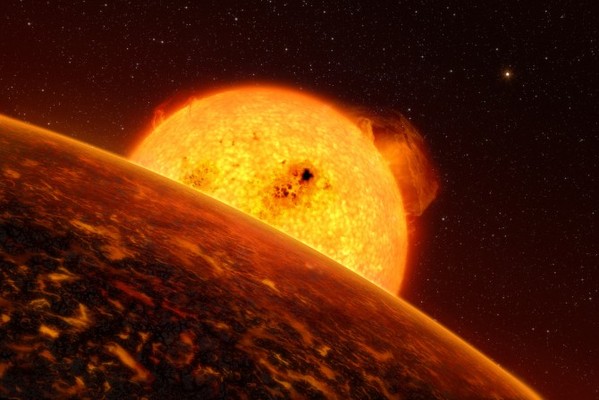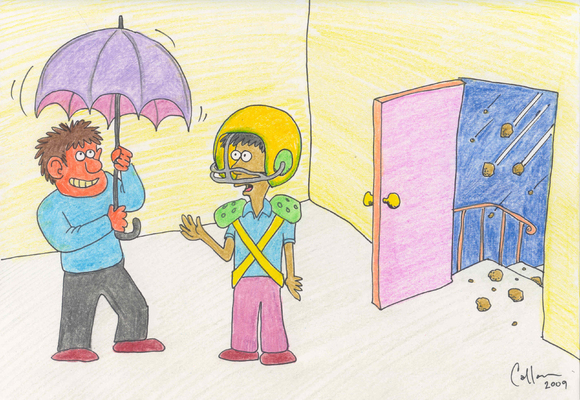
by Nicole Branan Thursday, January 5, 2012

CoRoT-7b, in an artist's rendering. EPA

'I hate to break it to you, but that umbrella is really not sufficient for the weather around here.' Callan Bentley
Next time you’re unhappy with the weather, be glad it’s not raining rocks. That seems to happen on CoRoT-7b, a hot, Earth-like planet about 500 light-years away from us. A new modeling study suggests that the exoplanet’s atmosphere is filled with the chemical components of rock, such as oxygen, sodium and silicon monoxide, and whenever these gases condense into clouds, rocky rain likely hammers down onto CoRoT-7b’s sweltering surface. The findings show that planets outside of our solar system can be quite different from ours, and they also suggest that it’s possible to get an oxygen-rich atmosphere by means other than photosynthetic life.
Scientists discovered CoRoT-7b last February when it moved in front of its star, CoRoT-7. The exoplanet’s mass — about five times that of Earth — suggested that the planet had sufficient gravity to hold on to an atmosphere but no one knew what that atmosphere was made of. So Bruce Fegley and Laura Schaefer of Washington University in St. Louis, Mo., ran model simulations to find out.
Fegley and Schaefer needed to know the planet’s surface temperature and its chemical composition. Previous work determined CoRoT-7b orbits its star at a mere distance of 2.6 million kilometers — about 23 times closer than Mercury is to our sun. As a result, the exoplanet’s surface temperature can reach a sizzling 2,300 degrees Celsius, estimates have shown.
Finding out what elements linger on the exoplanet was much trickier, but Fegley and Schaefer had some hints. For example, observations had shown that CoRoT-7b is a rocky planet like Earth. But calculations suggested that, unlike Earth, the lighter, more volatile portion of the periodic table — elements such as hydrogen, carbon, nitrogen, sulfur and chlorine — were “boiled off the planet” a long time ago, Fegley says. And CoRoT-7b doesn’t have any sources that could continuously fill the atmosphere back up with these elements. Chlorine, for example, is abundant in seawater, but CoRoT-7b doesn’t appear to have any oceans.
“So there goes your source of chlorine,” he says. One exception is oxygen: It’s even lighter than chlorine, but CoRoT-7b probably still has oodles of it because the element is often the main component of rocks, the material that CoRoT-7b is made of, he says.
Taking these considerations into account, Fegley and Schaefer modeled a number of plausible rock recipes, including those of Earth’s continental and oceanic crust and the makeup of the moon, they reported in the Astrophysical Journal. They saw that regardless of the composition of CoRoT-7b’s rock, the same thing always happened: Rocks vaporized, loading the atmosphere mainly with sodium, oxygen and silicon monoxide gas. And once an atmosphere contains only components of rock, that’s what rain will consist of simply because “that’s all there is,” Fegley says.
“It’s fascinating that there are planets that are so different from Earth and that have these really interesting atoms and molecules in the atmosphere,” says Sara Seager of MIT in Cambridge, Mass., who was not involved in the study. So far, scientists have no direct observations of CoRoT-7b’s atmosphere, but the findings will give them guidance as to what to look for, Seager says. For example, the new study predicts sodium and potassium in the upper atmosphere. These two elements are relatively easy to detect, and if scientists were to find them, they would have one indication that the model might be correct, Fegley says.
The new findings also show that a planet can have an oxygen-rich atmosphere without the presence of life, Fegley says. Most scientists have long thought photosynthesis was the only way to accumulate large amounts of oxygen in an atmosphere. But the team’s calculations show that “if you have oxygen that doesn’t necessarily mean that it’s life — it could be vaporized rock,” he says. Until now, no one knew of an example of a planet whose temperature was as high as that on CoRoT-7b, so this possibility hadn’t come up, Fegley adds. “I think this is a unique case to date.”
© 2008-2021. All rights reserved. Any copying, redistribution or retransmission of any of the contents of this service without the expressed written permission of the American Geosciences Institute is expressly prohibited. Click here for all copyright requests.